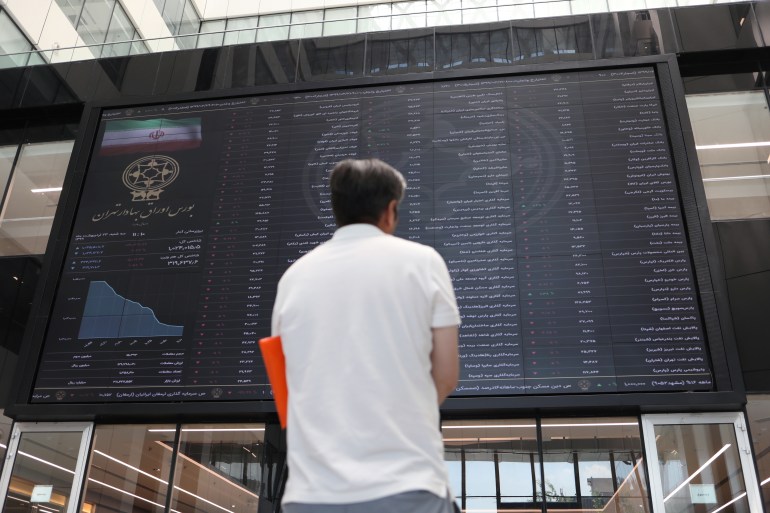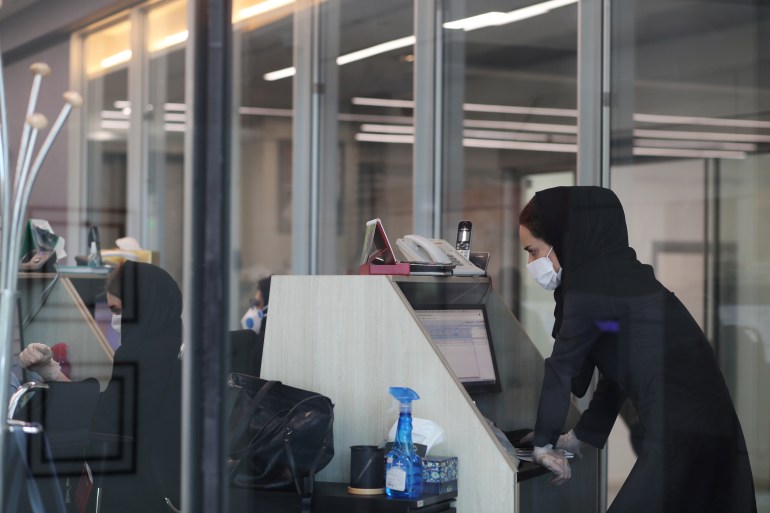What does Joe Biden’s presidency mean for Iran’s stock market?
Iran’s government encouraged people to jump into a red-hot market last year. Then the bubble burst.

Tehran, Iran – As 2019 was drawing to a close and the world was poised on the brink of an economy-ravaging pandemic, Iran’s Supreme Leader Ayatollah Ali Khamenei urged people to jump into the country’s red-hot stock market.
“I say to our dear people to certainly participate in productive investments if they can, including cooperatives and in some instances in bourse,” he said during a speech in November 2019.
Keep reading
list of 4 itemsAs US inflation ticks back up, it could impact the presidential election
Will the US unemployment rate continue at historic lows?
The UK’s new minimum wage ‘badly needed’ but many calling for more
The call was echoed by Iranian President Hassan Rouhani and his administration.
They were encouraging ordinary people to invest in equities as the country’s stock market was enjoying a steady upward trend.
The rally was sparked by Washington’s decision to unilaterally withdraw from the Iran nuclear deal with world powers in 2018 and unleash a torrent of sanctions to cripple Iran’s economy. That hammered Iran’s currency, the rial. And as the rial fell victim to crushing inflation, people shielded their rapidly eroding savings by investing in assets.
Many chose stocks. And government policies drove the bulls even harder.
In April 2020, Khamenei granted Rouhani’s request to release so-called “Justice Shares” in 49 state-owned companies to the Iranian people, and create exchange transaction codes to allow them to trade the stocks.
Then in May, the government started bundling shares in wholly and partially state-owned companies, allowing investors to buy a slice of those firms.
Another psychological boost for the markets was delivered when the government said it had earmarked one percent of foreign exchange reserves in Iran’s sovereign wealth fund to invest in the country’s stock market.
By May 2020, TEDPIX, the benchmark index of the Tehran Stock Exchange (TSE), surged past one million points for the first time ever.
Investment veterans and others warned the market was overheating. But the meteoric rise continued. By August, TEDPIX crossed the two-million-point threshold.
Then the bubble burst.

Angry investors
The TEDPIX is now hovering around the 1.29-million-point mark – more than 37 percent off its August high. During the ensuing selloff, the index experienced its largest one-day drop ever.
And the carnage is far more widespread than it would have been in the past.
Only 10 million people traded stocks on the TSE for its first 50 years of operations. Since early 2018, more than 11 million people have done so. Throw in all the people who can now actively trade Justice Shares, and that is more than 55 million Iranians – roughly two-thirds of the country’s population – who can trade stocks on the TSE.
Angry investors who saw their paper fortunes evaporate are not taking it lying down. Some have held protests in front of state-run buildings.
The latest was last week, when dozens protested in front of the TSE in western Tehran, chanting slogans like “they stole our money, now they brag with it”. Others directed their ire at the Rouhani administration.
The same day, local media published what it said was a resignation letter from TSE chief executive Hassan Ghalibaf Asl. He quickly denied he had authored it, saying “they may fire me but I haven’t resigned”. Then the next day, the TSE leadership council said his resignation had been approved.
The events unfolded shortly after members of parliament, including speaker Mohammad Bagher Ghalibaf, harshly criticised the government for the burst stock-market bubble.
Conservative speaker Ghalibaf is a staunch political opponent of President Rouhani and also ran against him in the 2017 presidential elections.

‘Short-term opportunities’
While many ordinary investors lost their shirts, the government managed to lock in real gains from the stock market bubble. Government companies saw an influx of cash as shares were sold into a rising market, while the country’s treasury took in a massive 670 percent year-over-year rise in taxes levied on trades, delivering a more than 134-trillion-rial ($595m) windfall to state coffers by the end of Iran’s third fiscal quarter in late December.
Some investment professionals are critical of the government for encouraging Iranians to jump into the stock market without adequately informing them of the potential risks.
“Instead of creating the grounds for professional investments that would benefit the real economy in addition to advancing the stock market, the government used short-term opportunities to account for a portion of its budget deficit,” investment manager and analyst Ali Khosroshahi told Al Jazeera.
Overall though, the stock market’s rise has only helped the economy marginally at best, said economist and market analyst Mehdi Haghbaali.
One supposed benefit of the stock market bubble, he said, is that it absorbed huge amounts of money circulating in the economy, slowing down inflation that has been on the rise under the combined pressure of United States sanctions and the COVID-19 pandemic.
“But there are serious doubts that this mechanism could have a permanent effect when the government keeps printing money,” Haghbaali told Al Jazeera.
Iran also experienced significant monthly inflation increases of 5.4 percent and 7.1 percent in the two months following the stock market crash, as the money that was taken out of stocks found its way to other assets like housing and cars.
“There is no clear evidence to indicate that the stock market boom has had any effect in controlling the inflation, which is driven by huge amounts of money supply,” Haghbaali said.

The Biden factor
Most market pros expect the steepest selloffs are behind the TSE, but political developments could inject more volatility into the market in the near term.
The TEDPIX skyrocketed in large part because people saw stocks as a hedge against inflation triggered by US sanctions. Many of the major companies listed in the TSE are export-heavy firms such as steel, petrochemicals and refineries that benefit from a weaker rial.
Since US President Joe Biden took up residence in the White House last week promising to reenter the Iran nuclear accord, the rial has strengthened slightly from 250,000 to $1 to roughly 220,000.
“At the heights of the Tehran stock market in August, the market was using an implicit dollar-to-rial rate of 600,000 for some stock valuations,” economist Haghbaali said.
“It was obvious that the investors were over-optimistic (or pessimistic) about what would happen next,” he said, noting that a survey of 20 Iranian chief executives and investment chiefs conducted by him and a group of economists before the US elections found that about two-thirds of them believed former President Donald Trump would win and the rial would devalue further.
A Biden win has strengthened hopes that Iran’s economy will bounce back and it can once more trade freely with foreign partners, something Haghbaali said could eventually translate into a stronger stock market.
“But this boom will be much slower than the rise of the past two years,” he said. “It will be more beneficial to everyone since it will be built on an improving economy.”